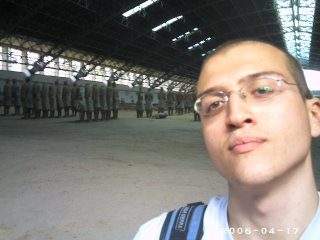Spring Break in the Heart of China

 We arrived in
We arrived in


On the next morning we went to
When you stand over the clouds on the highest peak a light effect that comes thought the clouds forms a Halo that has prompted many to jump of the cliff to join eternity. Luckily most stopped their pilgrimage a couple of centimeters before the fatal jump.

 Once this area was done, Simon had a great idea. At least it seamed great enough until I grasped the totality of it.
Once this area was done, Simon had a great idea. At least it seamed great enough until I grasped the totality of it.
We jumped on a bus to get to Kanding, the first step to the Tibetan plateaus. In fact,  otherwise while drawing the new boundaries in 1949. After 10 hours on the bus we stepped into the thick snow at 3000 meters altitude. The first thought was to figure out when the first bus back was. The city was nicely positioned at the base of a couple of very high mountains offering very pleasant views. The only attraction, which was a famous lake was too expensive for our shallow student pockets.
otherwise while drawing the new boundaries in 1949. After 10 hours on the bus we stepped into the thick snow at 3000 meters altitude. The first thought was to figure out when the first bus back was. The city was nicely positioned at the base of a couple of very high mountains offering very pleasant views. The only attraction, which was a famous lake was too expensive for our shallow student pockets.

 Back to Chengdu, we revised our plans. We were about to experience a train ride in
Back to Chengdu, we revised our plans. We were about to experience a train ride in
Meanwhile the chess score got to 12: 11 for Simon :-( I will nail him on the next one. The city was amazing to the point of saying that it is one of the few Chinese cities that actually has a charm and a pleasant character. The most beautiful part was the Muslim quarters of the city. They were the most picturesque and warm part of the city. Exactly like you would expect it in any place in the
This mosque was built in the hearth of china over 1250 years ago!!!! Not long after Mohamet made his journey in 622!


Our last stop was the city of Juzhaigou in the north of Sichuan inhabited only by Tibetans and Qiang people.
The region is known for its many multi-level waterfalls and colorful lakes , and was declared a UNESCO World Heritage Site as well. We bought a 2 day entrance ticket and walked a total of over 40km in two days.
Since we weren’t planning to come down to the city overnight we found ourselves sleeping in the house of a very hospitable Tibetan couple. The house was full of rats running around but, in the end, the smile of our hosts to our weird ways and our good humor was worth all of it.
Everywhere the water was Blue, green, fuscia, violet and clearer than air









<< Home